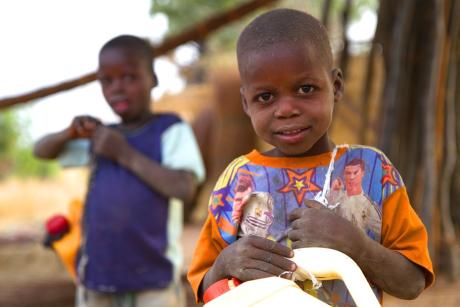
Aedes aegypti, the mosquito responsible for the spread of Zika and other viruses. Photo from Wikimedia Commons.
Published February 4, 2016, last updated on October 12, 2017 under Voices of DGHI
By Dr. Sulzhan Bali, second year MSc-GH student, Global Governance Futures 2027 Fellow
NOTE: This post was originally published on Global Health Now on February 4, 2016.
Zika—the new kid on the pandemic block—is emerging in the wake of Ebola, at a time when critical lessons learned from the world’s response to Ebola are still fresh and can serve a vital purpose. Zika, just like Ebola, is another fervent reminder of the fact that diseases and disease vectors respect no borders.
The effective tackling of epidemics requires surveillance, strong health systems and a swift response. The WHO’s declaration that clusters of microcephaly and birth defects thought to be related to Zika constitute a Public Health Emergency of International Concern (PHEIC) hopefully will accelerate the latter. However, there are other lessons to be learned from Ebola, that if not applied to Zika would render the act of declaring the disease a PHEIC futile.
Lesson #1—Controlling Misinformation through a Top-down Flow of Credible Information
During an “explosive” outbreak, there is a critical need to manage the panic brought on because of a lack of pertinent information. The Zika virus, like Ebola in West Africa, is a neglected disease that has spread beyond its traditional borders for the first time. There is a dearth of accurate information regarding the virus. Novel diseases in a region often cause people to unearth information on their own, often from unreliable sources. Misinformation not only promotes a false sense of security, but it also can encourage high-risk behavior during an epidemic. This was particularly evident during the Ebola outbreak in Nigeria, where people died from the consumption of salty water—a false Ebola-prevention measure. Providing swift and accurate top-down information in collaboration with multilateral organizations such as the Pan American Health Organization (PAHO) and World Health Organization (WHO), as well as with digital or social media platforms is essential. Countries can learn from the Nigerian government’s collaboration with EbolaAlert—a digital media platform that was used to ensure the dissemination of accurate Ebola information and to quell rumors.
Lesson #2—Mitigating the “Fearonomic Effect”
One of the biggest challenges created by diseases deemed PHIEC is when fear causes more harm than the disease itself. When the effects of diseases are amplified by fear and misinformation, this can lead to aversion behavior by individuals, organizations and countries. This is turn results in a “fearonomic effect” on the economies of affected countries. For example, during the most recent Ebola outbreak, 34 countries enacted trade and travel restrictions against WHO guidelines and in violation of article 43 of International Health Regulations (IHR). The trade and travel not only disrupted Ebola containment efforts but also detrimentally affected the economies of the Ebola-hit countries. Liberia, Sierra Leone and Guinea lost more than 12% of their GDP or $1.6 billion in foregone income due to aversion behavior.
As countries develop policies to address the imminent threat of the Zika virus, it is essential that they align with WHO recommendations. Many of the Zika-affected economies rely significantly on tourism. In fact, Brazil, the epicenter of the outbreak, is in a particularly dire situation with the 2016 Olympics around the corner and with a panic striking its aviation industry. Although the IHR do not contain an enforcement mechanism, a more authoritative role played by WHO will go a long way in ensuring nations comply with IHR.
Lesson #3—Collaboration, Synchronization and Coordination
Coordination between the Zika-affected countries would be key, especially because mosquitoes and pathogens do not respect state boundaries. With Ebola, it became clear early on that no individual organization on its own had the capacity to put up a comprehensive response. Zika is no different. Although PAHO has been doing a great job in orchestrating South America’s response to Zika, there is a need for a body like the Ebola Emergency Operations Centre (EEOC) in Nigeria. Such a center would be able to implement a streamlined top-down approach, partaking in surveillance and ensuring mobilization of the private sector.
Lesson #4—Engaging with the Private Sector
Private sector can play a key role in mobilizing resources during an epidemic, especially early on when resources are limited. Some of the worst Zika-hit areas are also the poorest. By utilizing the strengths of industry in preparing and sharing pandemic preparedness plans, research and development, procurement of supplies, and logistics, countries can generate a swift, coordinated response to Zika.
Lesson #5—Getting the Community and Traditional Community Leaders Involved
The Ebola epidemic highlighted the importance of community engagement in containment efforts. Community and religious leaders can play a persuasive role in reducing high-risk behavior, managing misinformation, and disseminating public health communication. With Zika, the community should be involved in integrated vector management and family planning as interventions to deal with the outbreak. This is essential as abortion is illegal and access to contraceptives is limited in many of the Zika-affected countries.
While many of the lessons from Ebola apply to Zika, it is essential to remember that these are two very different diseases. Unlike Ebola, Zika is a mosquito-borne disease with a unique set of challenges. With Zika topping the policy agenda, the global policy window is now wide open to develop horizontal approaches to address not only Zika but also the related Chikungunya and Dengue viruses. Declaration of Zika-related issues as a PHEIC will also bring attention to Arboviruses (spread via arthropods), which are also neglected tropical diseases. Aroboviral diseases are understudied, are more common in poverty-stricken areas and exacerbate poverty.
Like Ebola, Zika offers this final, crucial lesson: Neglected tropical diseases are no more just a problem of the developing world. We are, after all, only as strong as our weakest link.
Follow Sulzhan on Twitter: @sulzhan


